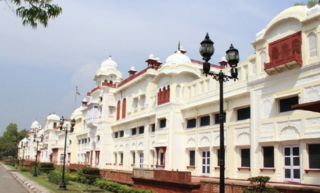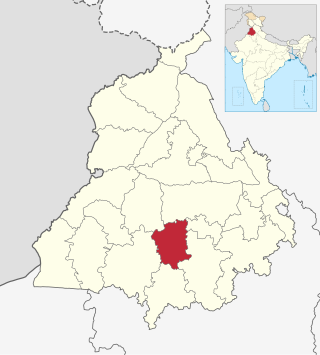
Patiala is a city in southeastern Punjab, northwestern India. It is the fourth largest city in the state and is the administrative capital of Patiala district. Patiala is located around the Qila Mubarak constructed by the Sidhu Jat Sikh chieftain Ala Singh, who founded the royal dynasty of Patiala State in 1763, and after whom the city is named.

Mansa is a city of Punjab. It is the administrative headquarters of Mansa district and is situated on the Bathinda-Jind-Delhi railway line and also on the Barnala-Sardulgarh-Sirsa state highway.

Patiala district is one of the twenty three districts in the state of Punjab in north-west India.

Majha is a region located in the central parts of the historical Punjab region split between India and Pakistan. It extends north from the right banks of the river Beas, and reaches as far north as the river Jhelum. People of the Majha region are given the demonym "Mājhī" or "Majhail". Most inhabitants of the region speak the Majhi dialect, which is the basis of the standard register of the Punjabi language. The most populous city in the area is Lahore on the Pakistani side, and Amritsar on the Indian side of the border.
Bhadaur is a town in Barnala district in the state of Punjab, India. It is part of the Bhadaur Assembly Constituency.

Bhawanigarh, earlier known as Dhode, is a town and a municipal council (Class-2) in the Sangrur district in the state of Punjab, India. It is also the headquarters of Bhawanigarh tehsil, which was formed in December 2016. The town is also called Dhode, after the clan of its original founders. The town lies 19 kilometres east of Sangrur on the Patiala-Sangrur road whereas Patiala is 39 kilometres east of Bhawanigarh. The literacy rate is higher than other places of Sangrur. Bhawanigarh is divided into 15 wards. The Bhawanigarh block consists of 66 villages in the Sangrur district.
Lehragaga is a town and a municipal council in Sangrur district in the Indian state of Punjab. It is near the border of Punjab and Haryana. Haryana is about 15 km from Lehragaga. Asia's largest CBG plant named Verbio India, is in Lehragaga. It has a railway station. In lehragaga there are many schools, colleges and financial institutes.
Sunam is a town and a tehsil, near city of Sangrur in Sangrur district in the Indian state of Punjab. The Railway Station of Sunam was renamed as Sunam Udham Singh Wala.
The Khangura is a gotra of Jat community from the Punjab region in India.
Malaudh was a Cis-Sutlej Phulkian princely state of India till 1846, after which it was merged into the Ludhiana District by the British when they annexed the territories around Ludhiana. The town of Malaudh, or Maloud, is situated at a distance of about 40 kilometres from Ludhiana on the Ludhiana-Malerkotla Road and is linked by approach road kup-payal road though village Rorian which is now part of it as Nagar Panchayat. It lies on 75°- 56' Longitude and 30° – 38' Latitude. Malaudh is a very ancient place which was known as Malla Udey or rise of the Mallas with whom Multan or Mallustan is associated and later got corrupted to Malaudh. There was a The Loharan about 1 kilometer on the southern side which has now disappeared. Malaudh has a government high school (co-educational), middle school for girls and a primary school for boys, a post office, primary health centre and a veterinary dispensary. Malaudh became a part of the Ludhiana District when it was formed out of the territories annexed by the British in 1846.

Nabha State, with its capital at Nabha, was one of the Phulkian princely states of Punjab during the British Raj in India. Nabha was ruled by Jat Sikhs of the Sidhu clan.

Barnala is one of the districts of Indian state of Punjab. It was carved out of Sangrur district, in November 2006. It is a centrally located district bordered by Ludhiana district on the north, Moga district on northwest, Bathinda district on west, Sangrur district on east and Mansa district on south. As per census 2011, Population of District Barnala is 5,96,294. Barnala boasts a significant number of colleges that offer a diverse range of educational opportunities in fields such as engineering, arts, medicine, and commerce. Furthermore, the town is renowned for its thriving industrial sector. Two main Industries: Trident Group and a large Industry producing Combines, Standard Combines were also established here.

Sangrur district is in the state of Punjab in northern India. Sangrur city is the district headquarters. It is one of the five districts in Patiala Division in the Indian state of Punjab. Neighbouring districts are Malerkotla (north), Barnala (west), Patiala (east), Mansa (southwest) and Fatehabad (Haryana) and Jind (Haryana) (south).

Patiala State was a self-governing princely state of the Empire of India, and one of the Phulkian States, that acceded to the Union of India upon Indian dominionship and partition. Patiala Kingdom/State was founded by Sidhu Jat Sikhs.
Karamgarh is a village in the Barnala district, Punjab, India. The village is about 10 kilometres (6.2 mi) far from the city of Barnala, on the Barnala to Malerkotla road. The revenue records and census reports of year 1901 show that the area of nizamat of Karamgarh was 1834sq miles which included four towns and 665 villages with a population of 500,635 people and a population of 273.0 per square mile.
Lehal, now Patiala, was the famous village because of the visit by Sikhs' ninth Guru but now this village is a part of Patiala city.

Bahadurpur is a village in the Sangrur District of the Indian state of Punjab. It is located at 4km from the holy site of Mastuana Sahib, 10km from Sangrur, 32 km from Barnala, on Sangrur-Barnala main road. It has a population of 8,367, according to the 2011 census.

Phulkian Misl was a Sikh misl named after Choudhary Phul Singh.
The village of Sehna is located in Barnala district of Punjab, India.

Ala Singh (1691–1765) was the first king of the princely state of Patiala.













